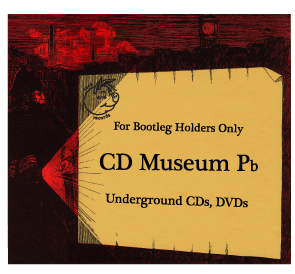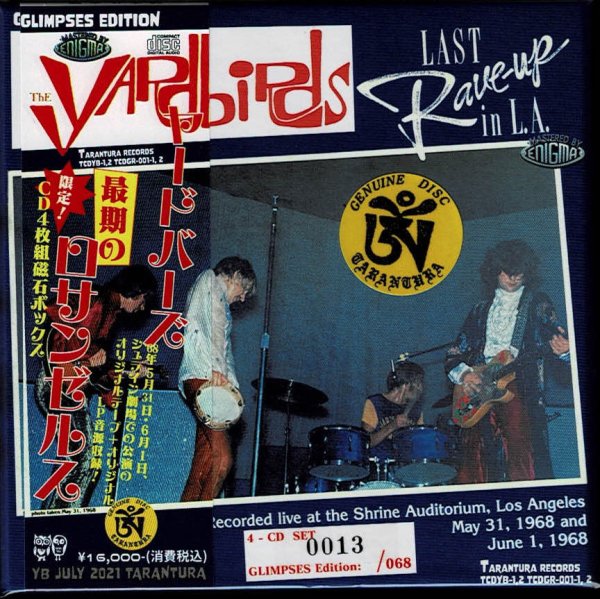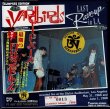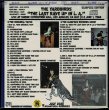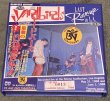GlIMPSES EDITION! The Yardbirds “The Last Rave UP in L. A.” 4 CD magnet box, Tarantura
GlIMPSES EDITION! The Yardbirds “The Last Rave UP in L. A.” 4 CD magnet box, Tarantura
Price: ¥16,000
Stock:Low stock
Item description
GlIMPSES EDITION!
THE YARDBIRDS “THE LAST RAVE UP IN L. A.”- 4 CD magnet box, Tarantura
Live at Shrine Exposition Hall, Los Angeles, Ca May 31 & June 1, 1968
Strictly limited edition of 68 copies, numbered!
Jimmy Page – Lead guitar
Keith Relf – Vocals
Chris Dreja – Bass
Jim McCarty – Drums
◉THE ORIGINAL TAPES
★May 31, 1968 Original Tape
TCDYB-1;
01. Introduction
02. The Train Kept A Rollin'
03. Mr You're A Better Man Than I
04. Heartful Of Soul
05. Dazed And Confused
06. Shapes Of Things
07. I'm A Man
08. Tune Ups
09. White Summer
10. Smokestack Lightning / Waiting For My Man
11. Bye Bye Bird
12. Happenings Ten Years Time Ago
13. Drinking Muddy Water
14. New York City Blues (Become My Friend) (aborted)
15. Intermission
16. I Wish You Would / Hey Gyp
★June 1, 1968 Original Tape
TCDYB-2;
01. Introduction
02. The Train Kept A Rollin'
03. Mr You're A Better Man Than I
04. Heartful Of Soul
05. Happenings Ten Years Time Ago
06. I Wish You Would / Hey Gyp
07. Drinking Muddy Water
08. New York City Blues (Become My Friend)
09. I Ain't Done Wrong
10. Over Under Sideways Down
◉THE GlIMPSES RECORDS GR001
★May 31, 1968 The Last Rave Up In LA LP Restored
TCDGR-001-1;
01. The Train Kept A Rollin'
02. Mr You're A Better Man Than I
03. Heartful Of Soul
04. Dazed And Confused
05. Shapes Of Things
06. I'm A Man
07. Tune Ups
08. White Summer
09. Smokestack Lightning / Waiting For My Man
10. Bye Bye Bird
★June 1, 1968 The Last Rave Up In LA LP Restored
TCDGR-001-2;
01. Happenings Ten Years Time Ago
02. I Wish You Would / Hey Gyp
03. Drinking Muddy Water
04. New York City Blues (Become My Friend)
05. I Ain't Done Wrong
06. Over Under Sideways Down
The Yardbirds recorded and toured extensively in England, Europe and the United States during the first half of 1968 before calling it quits after their final concert at Luton Technical College on 7 July. For example, their 1968 tour of the United States was the band's eighth and longest, lasting from 27 March through to 6 June. The story of the breakup is well known and will not be repeated here in any detail. In summary, after years of touring, two of the members - lead singer Keith Relf and drummer Jim McCarty - were moving in different musical directions arising, in part, out of the use of hallucinogenic drugs such as LSD, whilst lead guitarist Jimmy Page was beginning what would prove to be a globe-conquering live performance career. Bass player Chris Dreja initially wanted to carry on with Page, but also retired from the band at that stage to pursue a career in photography at the ripe old age of 21. A new, 4-piece Yardbirds was formed in August and began touring the following month, eventually changing its name to Led Zeppelin at the end of October. The Yardbirds were now just a memory, forever cast in the shadow of the global phenomenon that became Led Zeppelin. Eric Clapton's post-Yardbirds success with John Mayall's Bluesbreakers and Cream, and failure to acknowledge the important role played by the Yardbirds in his own development as a musician did not help their cause. All of this led to a diminishing of the band's reputation with time. Fortunately the quality of their recorded output and live performance over an extended period has ensured the Yardbirds maintain a significant cult status and worldwide fan base. Former lead guitarists Jeff Beck and Jimmy Page express pride in their work with the band, as do the other surviving members - Chris Dreja, Jim McCarty, Paul Samwell-Smith and Top Topham. The vocal and harmonica work of Relf is rightfully applauded for its soulfulness, innovation and significance in helping bridge the gap between blues, pop and modern, improvisational rock. The vocalisation of Robert Plant within Led Zeppelin is a natural progression of Relf's work with the Yardbirds.
What is most interesting from 1968 are the patchy live audio recordings. These reveal a significant development in the Yardbirds sound and stage presence. Psychedelic clothes, painted instruments, light shows and special effects were used to enhance the impact on the audience, many of whom were under the influence of then popular hallucinogenic drugs such as marijuana, hashish and LSD. The 1967 Summer of Love may have passed, but it's influence was still pronounced during 1968, especially in the areas of politics, music, fashion and alternate lifestyles, and most especially in the United States. Such was the transformation of the Yardbirds music over the relatively short period of time since the departure of Eric Clapton in March 1965, that by March of 1968 they sounded decidedly more Led Zeppelinish, rather than an updated, poppish version of John Mayall's Bluesbreakers. The Yardbirds had begun their musical journey as an early Sixties English rhythm and blues band, as revealed by recordings with Clapton and Sonny Boy Williamson between 1963-5. Clapton's replacement Jeff Beck facilitated a 20 month period during which R&B was supplanted by, and morphed into, pop and rock. When Jimmy Page took over lead guitar duties in October 1966 the Yardbirds evolved yet again, heavily influenced by what was happening in America, where they toured extensively. By 1968 the band were playing a mixture of psychedelic heavy rock, best exemplified by Happening Ten Years Times Ago and Dazed and Confused, and light acoustic material such as White Summer. The pop schlock imposed upon them in the studio by English producer Mickie Most was not representative of the Yardbirds live act or of their potential within the burgeoning album-oriented FM-radio market. The Yardbirds were not the world-conquering outfit that Led Zeppelin became a couple of years later, but they were awfully close in regards to onstage presence and dynamics.
Though the Yardbirds were extremely busy, little has been written about the band during this period, despite information such as detailed timelines being readily at hand. Jimmy Page has himself commented upon this in recent times. The 4-piece of 1967-8 is seen as an unsuccessful pop singles band - due to the low quality of many of their studio recordings - and a mere testing ground for Page's flowering with Led Zeppelin. As someone said, they were "dying on their feet" during this period and generally downplays any significance as a live act. Of course this is far from the truth, for the Yardbirds were one of the most successful pop and rock groups of their time, touring and playing to large audiences in Britain, Europe, Australasia and the United States, especially after Peter Grant took over management in early 1967 and ensured that some of the money coming in went to the band members. For example, many American musicians refer to the influence of the Yardbirds, highlighting the fact that the touring by the band during 1967 and 1968 left an indelible impression. An example of this is the group Aerosmith, who went on to record and perform a number of Yardbirds songs during the 1980s and beyond. Joe Perry, Alice Cooper, Ronnie Montrose and Tom Petty are just some of those who saw, and were influenced by, the Yardbirds during the band's final days. Individual audiences numbered in the thousands during the 1968 performances and they were entertained by a group of young, experienced and mostly energetic musicians. By the beginning of 1968 the 4-piece was a musically tight unit, with a well-developed stage act comprising hits from the past and new, expansive material. Their tendency towards extended improvisation began with the R&B "rave ups" from the Clapton era and fitted easily into the psychedelic, heavy rock jamming which became common later in the decade and was popularised by bands such as Cream, Santana and the Grateful Dead alongside, of course, the Yardbirds. Page and Grant were very much aware of their impact and built upon the Yardbirds experiences when Led Zeppelin so successfully hit the United States stadiums and auditoriums such as Fillmore West and East between 1969-71.
The sad fact is that live performances by the Yardbirds during 1968 were not adequately recorded for posterity or released during their lifetime. A collection of low quality bootleg tapes and a single official release exist, but all are flawed. Remastering of extant material by Page awaits the band's many fans. The few live television performances and BBC radio sessions are the best record of the band during its final days, and recent remastering of this material has enhanced its quality. A cleaned up version of the band's only official live release - the Anderson Theatre, New York gig from March 1968 - had brought nothing new but the same material that has been cleaned up. Some of the American concert posters, such as Lee Conklin's Fillmore 23-25 May poster, ensure that the Yardbirds place in the cultural milieu that was America in the Sixties remains in the spotlight and will not easily be forgotten. From 1963 through to the middle of 1968 the Yardbirds were rightly considered one of the world’s top recording and live pop / rock groups. This is clearly seen from their activity during 1968. Poor management prior to 1968, an inappropriate record producer in Mickie Most, and constant in-hindsight comparisons with Led Zeppelin cannot diminish the achievements of the Yardbirds during their final days. Some of those achievements are outlined below.
In 1983, Jimmy Page was interviewed and revealed some insights: We knew [the American tour] was going to be the last one, and all the pressure was off. We played well and had a really good time. We even managed to play consistently good venues; it was almost entirely universities and psychedelic ballrooms. The only low point was the Andersen Theatre gig in New York, which was recorded for a live album. The then rats at Epic had got wind of the break-up and decided to get the last drop of potential profit out of us. It was pure convenience for them, being based in New York, where we didn't like playing anyway. It should have been done at somewhere like the Shrine, in LA, or the Fillmore. The Anderson Theatre was a horrible place, very cold and unfriendly, and it didn't help that the Vanilla Fudge, currently local heroes, were playing across town at the Fillmore East. To cap it all, the Epic sound team had no idea how to record us. They were really straight and they just draped a few mikes around. It was pathetic. When they discovered the inadequacies of the recording, they dubbed on all those ridiculous bullfight cheers."
As for the Shrine shows, this 4 disk set brings up with two primitive 1968 audience recordings of two Yardbirds concerts, recorded May 31 and June 1 at The Shrine Exposition Hall in Los Angeles, California. This was originally released as a 3 LP vinyl bootleg titled "The Last Rave Up In LA" on Glimpses label, then later as a limited, hand-numbered 2CDR set on the Goldtone label under the same name. Goldtone obviously had access to the original tapes, because, though they dropped at least one track from the May 31 show (Glimpses) they present many previously unreleased takes. The vinyl set presented only a few tracks from the June 1 set, but the CDR edition apparently presents the entirety of the June 1 show.
Dave Cole, who taped both shows, revealed some insights about of how he recorded them: "To clear thngs up. I recorded the Yardbirds at Shrine. Both nights. The recorder was under my girl friends dress. (Pam, who become my first wife.) It was a brand new RCA table model 'portable' stereo cassete recorder. The mikes were Sony 15 dollars each. The mike wires were threaded through the sleeves of my levi jacket and over to the recorder. So we had to stand side by side. That’s me shouting “Sit down Goddammit” at the beginning. My friend Dale Strange had a friend who did vinyl bootlegs. We chose what seemed to be the best tracks to keep the album on three records. Dale found the guy who had taken photographs and those are on the box set. I wrote the liner notes and inside insert. There were two series of hand numbered Dale and I were involved with. The later unnumbered bootlegs and Goldtone CD I suspect were done by the bootlegger. He continued to sell these on ebay. Neither Dale or I tried to make money on it. It was strictly released as an act of love. It was our dollar outlays that financed the pressings. I never met the bootlegger, who was apoarently in it for the money after Dale died. Once I talked to the ebay salesman on the phone who admitted he knew Dale, but was cagey about admitting it was he who originally pressed the album and still selling it. No one has the original cassettes but me. The night before Dale died of a ruptured esophagus from alcoholism, he called me and told me he was scared. I ended up losing lots of my recording equipment, drums and recordings which were in Dale’s house, which was taken by Dale’s new wife’s family. (She, Joanna, passed away in a car accident on the way to church to offer candles on the one year anniversary of Dale’s death.)"
The quality of the sound has been now significantly improved and restored, this is a must for Yardbirds and Jimmy Page fans and it really shows what a powerful group the Yardbirds were as a live band. The first two discs are taken from low gen copies that contains both shows in complete form (albeit June 1 seemed to be missing some tracks per few cuts on the tape). The next two discs are featuring restored LP set, and contains highlights from two nights.
THE YARDBIRDS “THE LAST RAVE UP IN L. A.”- 4 CD magnet box, Tarantura
Live at Shrine Exposition Hall, Los Angeles, Ca May 31 & June 1, 1968
Strictly limited edition of 68 copies, numbered!
Jimmy Page – Lead guitar
Keith Relf – Vocals
Chris Dreja – Bass
Jim McCarty – Drums
◉THE ORIGINAL TAPES
★May 31, 1968 Original Tape
TCDYB-1;
01. Introduction
02. The Train Kept A Rollin'
03. Mr You're A Better Man Than I
04. Heartful Of Soul
05. Dazed And Confused
06. Shapes Of Things
07. I'm A Man
08. Tune Ups
09. White Summer
10. Smokestack Lightning / Waiting For My Man
11. Bye Bye Bird
12. Happenings Ten Years Time Ago
13. Drinking Muddy Water
14. New York City Blues (Become My Friend) (aborted)
15. Intermission
16. I Wish You Would / Hey Gyp
★June 1, 1968 Original Tape
TCDYB-2;
01. Introduction
02. The Train Kept A Rollin'
03. Mr You're A Better Man Than I
04. Heartful Of Soul
05. Happenings Ten Years Time Ago
06. I Wish You Would / Hey Gyp
07. Drinking Muddy Water
08. New York City Blues (Become My Friend)
09. I Ain't Done Wrong
10. Over Under Sideways Down
◉THE GlIMPSES RECORDS GR001
★May 31, 1968 The Last Rave Up In LA LP Restored
TCDGR-001-1;
01. The Train Kept A Rollin'
02. Mr You're A Better Man Than I
03. Heartful Of Soul
04. Dazed And Confused
05. Shapes Of Things
06. I'm A Man
07. Tune Ups
08. White Summer
09. Smokestack Lightning / Waiting For My Man
10. Bye Bye Bird
★June 1, 1968 The Last Rave Up In LA LP Restored
TCDGR-001-2;
01. Happenings Ten Years Time Ago
02. I Wish You Would / Hey Gyp
03. Drinking Muddy Water
04. New York City Blues (Become My Friend)
05. I Ain't Done Wrong
06. Over Under Sideways Down
The Yardbirds recorded and toured extensively in England, Europe and the United States during the first half of 1968 before calling it quits after their final concert at Luton Technical College on 7 July. For example, their 1968 tour of the United States was the band's eighth and longest, lasting from 27 March through to 6 June. The story of the breakup is well known and will not be repeated here in any detail. In summary, after years of touring, two of the members - lead singer Keith Relf and drummer Jim McCarty - were moving in different musical directions arising, in part, out of the use of hallucinogenic drugs such as LSD, whilst lead guitarist Jimmy Page was beginning what would prove to be a globe-conquering live performance career. Bass player Chris Dreja initially wanted to carry on with Page, but also retired from the band at that stage to pursue a career in photography at the ripe old age of 21. A new, 4-piece Yardbirds was formed in August and began touring the following month, eventually changing its name to Led Zeppelin at the end of October. The Yardbirds were now just a memory, forever cast in the shadow of the global phenomenon that became Led Zeppelin. Eric Clapton's post-Yardbirds success with John Mayall's Bluesbreakers and Cream, and failure to acknowledge the important role played by the Yardbirds in his own development as a musician did not help their cause. All of this led to a diminishing of the band's reputation with time. Fortunately the quality of their recorded output and live performance over an extended period has ensured the Yardbirds maintain a significant cult status and worldwide fan base. Former lead guitarists Jeff Beck and Jimmy Page express pride in their work with the band, as do the other surviving members - Chris Dreja, Jim McCarty, Paul Samwell-Smith and Top Topham. The vocal and harmonica work of Relf is rightfully applauded for its soulfulness, innovation and significance in helping bridge the gap between blues, pop and modern, improvisational rock. The vocalisation of Robert Plant within Led Zeppelin is a natural progression of Relf's work with the Yardbirds.
What is most interesting from 1968 are the patchy live audio recordings. These reveal a significant development in the Yardbirds sound and stage presence. Psychedelic clothes, painted instruments, light shows and special effects were used to enhance the impact on the audience, many of whom were under the influence of then popular hallucinogenic drugs such as marijuana, hashish and LSD. The 1967 Summer of Love may have passed, but it's influence was still pronounced during 1968, especially in the areas of politics, music, fashion and alternate lifestyles, and most especially in the United States. Such was the transformation of the Yardbirds music over the relatively short period of time since the departure of Eric Clapton in March 1965, that by March of 1968 they sounded decidedly more Led Zeppelinish, rather than an updated, poppish version of John Mayall's Bluesbreakers. The Yardbirds had begun their musical journey as an early Sixties English rhythm and blues band, as revealed by recordings with Clapton and Sonny Boy Williamson between 1963-5. Clapton's replacement Jeff Beck facilitated a 20 month period during which R&B was supplanted by, and morphed into, pop and rock. When Jimmy Page took over lead guitar duties in October 1966 the Yardbirds evolved yet again, heavily influenced by what was happening in America, where they toured extensively. By 1968 the band were playing a mixture of psychedelic heavy rock, best exemplified by Happening Ten Years Times Ago and Dazed and Confused, and light acoustic material such as White Summer. The pop schlock imposed upon them in the studio by English producer Mickie Most was not representative of the Yardbirds live act or of their potential within the burgeoning album-oriented FM-radio market. The Yardbirds were not the world-conquering outfit that Led Zeppelin became a couple of years later, but they were awfully close in regards to onstage presence and dynamics.
Though the Yardbirds were extremely busy, little has been written about the band during this period, despite information such as detailed timelines being readily at hand. Jimmy Page has himself commented upon this in recent times. The 4-piece of 1967-8 is seen as an unsuccessful pop singles band - due to the low quality of many of their studio recordings - and a mere testing ground for Page's flowering with Led Zeppelin. As someone said, they were "dying on their feet" during this period and generally downplays any significance as a live act. Of course this is far from the truth, for the Yardbirds were one of the most successful pop and rock groups of their time, touring and playing to large audiences in Britain, Europe, Australasia and the United States, especially after Peter Grant took over management in early 1967 and ensured that some of the money coming in went to the band members. For example, many American musicians refer to the influence of the Yardbirds, highlighting the fact that the touring by the band during 1967 and 1968 left an indelible impression. An example of this is the group Aerosmith, who went on to record and perform a number of Yardbirds songs during the 1980s and beyond. Joe Perry, Alice Cooper, Ronnie Montrose and Tom Petty are just some of those who saw, and were influenced by, the Yardbirds during the band's final days. Individual audiences numbered in the thousands during the 1968 performances and they were entertained by a group of young, experienced and mostly energetic musicians. By the beginning of 1968 the 4-piece was a musically tight unit, with a well-developed stage act comprising hits from the past and new, expansive material. Their tendency towards extended improvisation began with the R&B "rave ups" from the Clapton era and fitted easily into the psychedelic, heavy rock jamming which became common later in the decade and was popularised by bands such as Cream, Santana and the Grateful Dead alongside, of course, the Yardbirds. Page and Grant were very much aware of their impact and built upon the Yardbirds experiences when Led Zeppelin so successfully hit the United States stadiums and auditoriums such as Fillmore West and East between 1969-71.
The sad fact is that live performances by the Yardbirds during 1968 were not adequately recorded for posterity or released during their lifetime. A collection of low quality bootleg tapes and a single official release exist, but all are flawed. Remastering of extant material by Page awaits the band's many fans. The few live television performances and BBC radio sessions are the best record of the band during its final days, and recent remastering of this material has enhanced its quality. A cleaned up version of the band's only official live release - the Anderson Theatre, New York gig from March 1968 - had brought nothing new but the same material that has been cleaned up. Some of the American concert posters, such as Lee Conklin's Fillmore 23-25 May poster, ensure that the Yardbirds place in the cultural milieu that was America in the Sixties remains in the spotlight and will not easily be forgotten. From 1963 through to the middle of 1968 the Yardbirds were rightly considered one of the world’s top recording and live pop / rock groups. This is clearly seen from their activity during 1968. Poor management prior to 1968, an inappropriate record producer in Mickie Most, and constant in-hindsight comparisons with Led Zeppelin cannot diminish the achievements of the Yardbirds during their final days. Some of those achievements are outlined below.
In 1983, Jimmy Page was interviewed and revealed some insights: We knew [the American tour] was going to be the last one, and all the pressure was off. We played well and had a really good time. We even managed to play consistently good venues; it was almost entirely universities and psychedelic ballrooms. The only low point was the Andersen Theatre gig in New York, which was recorded for a live album. The then rats at Epic had got wind of the break-up and decided to get the last drop of potential profit out of us. It was pure convenience for them, being based in New York, where we didn't like playing anyway. It should have been done at somewhere like the Shrine, in LA, or the Fillmore. The Anderson Theatre was a horrible place, very cold and unfriendly, and it didn't help that the Vanilla Fudge, currently local heroes, were playing across town at the Fillmore East. To cap it all, the Epic sound team had no idea how to record us. They were really straight and they just draped a few mikes around. It was pathetic. When they discovered the inadequacies of the recording, they dubbed on all those ridiculous bullfight cheers."
As for the Shrine shows, this 4 disk set brings up with two primitive 1968 audience recordings of two Yardbirds concerts, recorded May 31 and June 1 at The Shrine Exposition Hall in Los Angeles, California. This was originally released as a 3 LP vinyl bootleg titled "The Last Rave Up In LA" on Glimpses label, then later as a limited, hand-numbered 2CDR set on the Goldtone label under the same name. Goldtone obviously had access to the original tapes, because, though they dropped at least one track from the May 31 show (Glimpses) they present many previously unreleased takes. The vinyl set presented only a few tracks from the June 1 set, but the CDR edition apparently presents the entirety of the June 1 show.
Dave Cole, who taped both shows, revealed some insights about of how he recorded them: "To clear thngs up. I recorded the Yardbirds at Shrine. Both nights. The recorder was under my girl friends dress. (Pam, who become my first wife.) It was a brand new RCA table model 'portable' stereo cassete recorder. The mikes were Sony 15 dollars each. The mike wires were threaded through the sleeves of my levi jacket and over to the recorder. So we had to stand side by side. That’s me shouting “Sit down Goddammit” at the beginning. My friend Dale Strange had a friend who did vinyl bootlegs. We chose what seemed to be the best tracks to keep the album on three records. Dale found the guy who had taken photographs and those are on the box set. I wrote the liner notes and inside insert. There were two series of hand numbered Dale and I were involved with. The later unnumbered bootlegs and Goldtone CD I suspect were done by the bootlegger. He continued to sell these on ebay. Neither Dale or I tried to make money on it. It was strictly released as an act of love. It was our dollar outlays that financed the pressings. I never met the bootlegger, who was apoarently in it for the money after Dale died. Once I talked to the ebay salesman on the phone who admitted he knew Dale, but was cagey about admitting it was he who originally pressed the album and still selling it. No one has the original cassettes but me. The night before Dale died of a ruptured esophagus from alcoholism, he called me and told me he was scared. I ended up losing lots of my recording equipment, drums and recordings which were in Dale’s house, which was taken by Dale’s new wife’s family. (She, Joanna, passed away in a car accident on the way to church to offer candles on the one year anniversary of Dale’s death.)"
The quality of the sound has been now significantly improved and restored, this is a must for Yardbirds and Jimmy Page fans and it really shows what a powerful group the Yardbirds were as a live band. The first two discs are taken from low gen copies that contains both shows in complete form (albeit June 1 seemed to be missing some tracks per few cuts on the tape). The next two discs are featuring restored LP set, and contains highlights from two nights.
